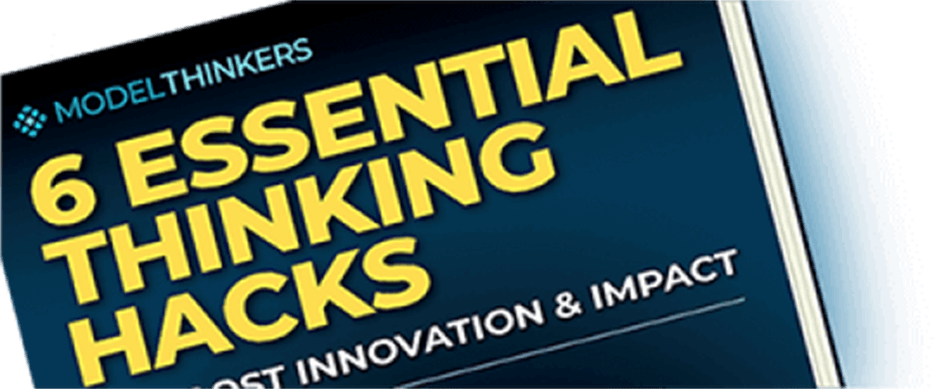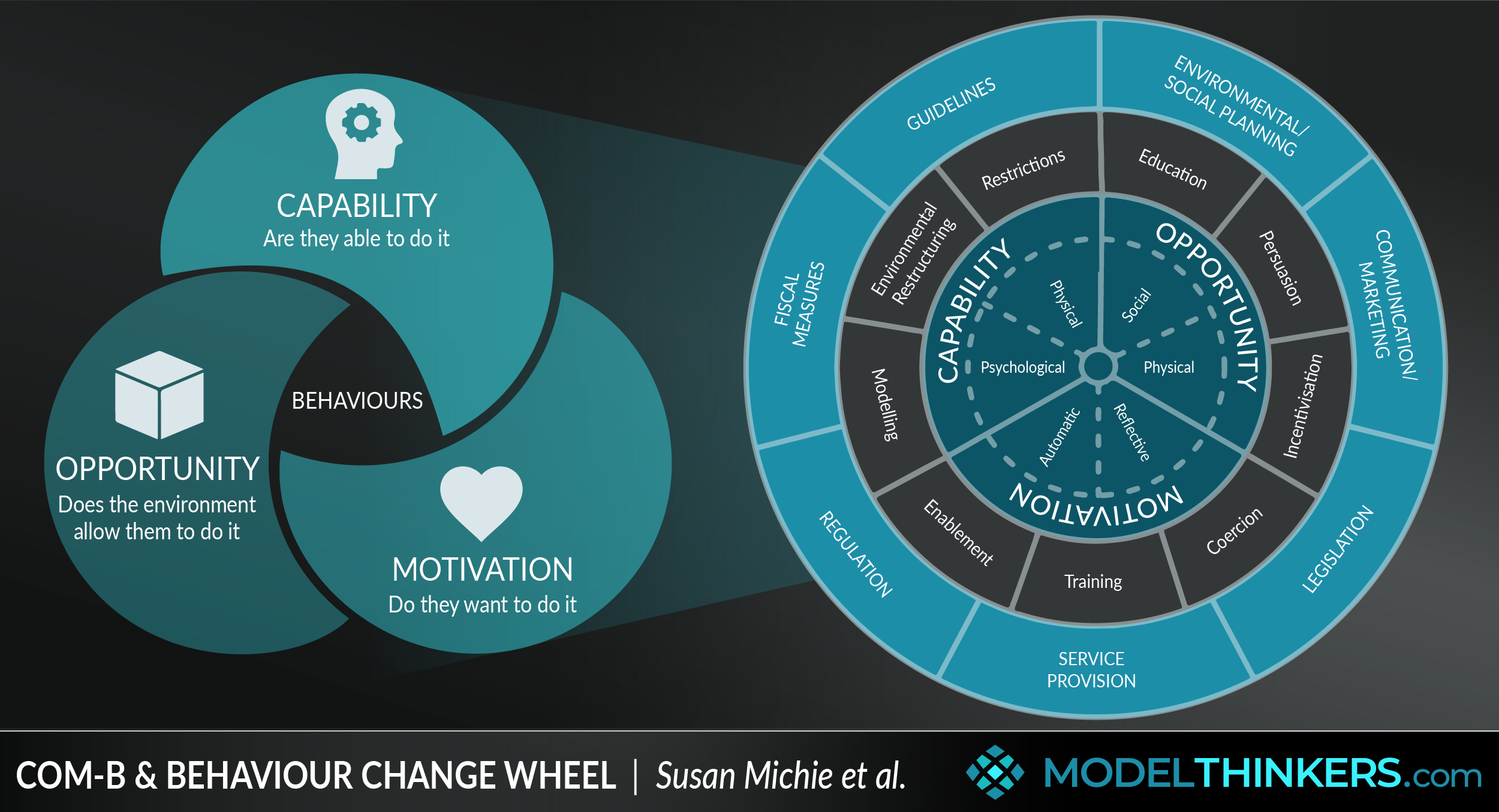COM-B & Behaviour Change Wheel
Whether you’re shaping the culture of a team, shifting customer behaviour as part of a product launch, or wanting to change and improve yourself, you’ll need to understand the art and science of behavioural change. The Behaviour Change Wheel is a great place to start that journey because it distils impactful behavioural strategies from 19 existing models into a single framework.
The Behaviour Change Wheel (BCW) is a framework for describing, designing and evaluating behaviour change strategies. At its heart is the COM-B behaviour model, which posits that Behaviour occurs as an interaction between Capability, Opportunity, and Motivation.
USING COM-B.
COM-B forms the centre of the Behavioural Change Wheel and consists of three key elements that influence behaviour. COM-B might be enough for your needs, but if you want to go deeper you can explore two sub-elements for Capability, Opportunity and Motivation. Still want more? Then you can go further with the Theoretical Domain Framework (TDF) which cites 14 categories of behavioural elements. The COM-B sub-elements and TDF are mapped against COM-B below:
____
SUB- ELEMENTS
TDF
QUESTIONS TO EXPLORE RELEVANCE
C
A
P
A
B
I
L
I
T
Y
Physical - skills and knowledge such as operating equipment or tools.
Physical skill
Do they have the ability to adopt the target behaviours:
Are they aware of the behaviour and what it involves?
Do they know how to do it?
Do they have the understanding required to do it?
Do they have the skill, strength and stamina to do it?
Do they have the cognitive and perceptual skills do it?
Psychological - skills and knowledge such as decision-making.
Knowledge
Cognitive and interpersonal skills
Memory, attention and decision process
Behavioural regulation
O
P
P
O
R
T
U
N
I
T
Y
Physical - the environment, time and resources. E.g. giving up smoking by going to a place where smoking is not allowed.
Environmental context and resources
Do they have the opportunity to adopt the target behaviours:
Is it socially acceptable in their environment?
Do formal rules support it?
Are there cues, reminders, and nudges supporting them to do it?
Do they have sufficient time to do it?
Do they have access to the appropriate place to do it?
Do they have the appropriate resources such as money, tools, or equipment to do it?
Social - behaviour and expectations of peers and networks including cultural norms. E.g. giving up smoking with a support group of non-smokers.
Social influences
M
O
T
I
V
A
T
I
O
N
Reflective - thought processes such as plans, beliefs and intentions. E.g. planning to stop smoking because of the health benefits.
Professional/ social role and identity
Beliefs about capabilities
Optimism
Beliefs about consequences
Intentions
Are they motivated to adopt the target behaviours:
How worthwhile do they think it is?
How much satisfaction or rewards do they expect to obtain from it?
How much do they think it will meet a need?
How well does it fit with their self-identity?
How strong is their intention around it?
How developed is their habit or routine around it?
How much do they prioritise it over the alternatives?
Automatic - more intrinsic such as emotional responses, desires, and impulses. E.g. physical response to the thought of smoking.
Reinforcement
Emotion
INTERVENTIONS AND POLICIES.
The middle circle on the wheel after COM-B captures types of interventions that can support the required behaviour change. The outer wheel represents policy classifications that such interventions might fall under.
The policy categories are environmental and social planning; communication and marketing; legislation; service proposition; regulation; fiscal measures; and guidelines. Perhaps a more practical lens, however, are the interventions which we’ve broken down further below:
INTERVENTION
DEFINITION
LINK TO COM-B & SUB ELEMENTS
Education
Informing and explaining to increase knowledge and understanding.
Capability - psychological.
Motivation - reflective.
Persuasion
Influencing to develop positive or negative feelings that stimulate action.
Motivation - reflective or automatic
Incentivisation
Establishing rewards and incentives.
Motivation - reflective or automatic
Coercion
Establishing punishments and costs.
Motivation - reflective or automatic
Training
Developing knowledge and skills.
Capability - psychological or physical.
Motivation - reflective or automatic.
Enablement
Increase means or reduce barriers to increase capability (beyond education and training) or opportunity (beyond environmental restructuring). E.g. surgery to reduce obesity or prostheses to promote physical activity.
Capability - psychological or physical.
Motivation - (indirectly) reflective or automatic.
Modelling
Providing a role model or example.
Opportunity - social.
Environmental restructuring
Changing the social or physical environment.
Opportunity - social or physical.
Capability - psychological or physical.
Motivation - reflective or automatic.
Restriction
Using rules or laws to change behaviours.
Opportunity - social or (indirectly) physical.
DESIGNING AND DELIVERING INTERVENTIONS.
The creators of the BCW framework suggest several steps to designing a behavioural change intervention.
Understand target behaviour and audience:
Define the problem in behavioural terms
Select target behaviour (what you will change to address the problem)
Specify target behaviour (what, where, when, how, with whom, in what context…)
Understand what needs to change to achieve the target behaviour (using COM-B or TDF.)
Design interventions:
Identify potential interventions
Identify behavioural change techniques
Deliver interventions:
Select mode of delivery
Select policy categories
What isn’t captured in the above list, is the process of using Split Tests, Prototypes and broader experimentation to asses which of the interventions will have the most impact on your target group, in your unique context. That said, the BCW creators do suggest applying their APEASE model for assessing which interventions and policies to implement which stands for Acceptability, Practicality, Effectiveness, Affordability, Spillover effects and Equity.
IN YOUR LATTICEWORK.
Similar to many behavioural change models, it’s worth considering this framework in the context of Behavioural Economics and Kahnenman’s Fast and Slow Thinking. It works well with other change-relevant models such as the nudge-inspired EAST Framework, as well as the Habit Loop, Systems vs Goals, and Ulysses Pact.





